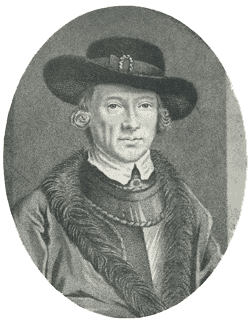Captain William Baillie, Engraver
(b. 1723, d. 1810)
Engraver
From A Dictionary of Irish Artists 1913

William Baillie. Engraved by Himself.
Was second son of Robert Baillie of Celbridge, County Kildare, a member of the family, now extinct, of Baillie of Sherwood Park, Kilbride, County Carlow, and was born at Kilbride on 5th June, 1723. He was educated at Dr. Sheridan's school in Dublin, and on the 10th May, 1742, entered the Middle Temple with the intention of becoming a lawyer. He, however, accepted a commission as ensign in the 13th regiment of foot, and with it served at Culloden under the Duke of Cumberland, and in several engagements in Germany under the Marquess of Granby. In 1756, when the 51st regiment was raised he obtained a company and was with his regiment as captain of Grenadiers and paymaster, at the battle of Minden. In 1761 he exchanged into the 3rd Light Dragoons, but after a few years, his health failing, he sold his commission, and in 1773 obtained the appointment of Commissioner of Stamps. He retired on pension in 1795.
He devoted his leisure to art, practising engraving in all its forms. He was considered one of the most accomplished connoisseurs of his time, and was associated with Nathaniel Hone in the formation of Lord Bute's collection. Most of his engraved work, chiefly after pictures by the old Masters, was done between his retirement from the army and 1787; but some of his original etchings are dated as early as 1753. One or two of these are inscribed W. Baillie capo di 3o Rego Caval. Legiera. He worked in mezzotint, etching and stipple, and in the latter method he reproduced a number of drawings in Lord Bute's and other private collections.
He did several copies after Rembrandt's etchings, notably "The Gold-weigher" and "The Three Trees," and achieved fame by his restoration of the original plate of the "Hundred Guilder Print" which had come into his possession. He exhibited impressions from the plate, before and after its restoration, with the Society of Artists in London, in 1776. He afterwards divided the plate into four. Among other etchings by him are "Christ and the Disciples at Emmaus," after Rembrandt; "Christ washing the feet of the Apostles," after Rubens; "Susanna and the Elders before Daniel," after Eeckhout; and "William, Prince of Orange," after Terborch. In mezzotint he did a "Portrait of Frans Hals," and portraits of "Sophonisba Anguisciola," "Cornelis de Witt," "James, Duke of Monmouth," and Hone's picture of "The Piping Boy." He exhibited thirty-one etchings and mezzotints with the Society of Artists between 1762 and 1776.
Most of his plates when somewhat worn fell into the hands of Boydell, who republished them in two folio volumes in 1792. They were re-issued in 1803. Baillie, although he had no early artistic training, was an able engraver, particularly in mezzotint and stipple. His prints are inscribed, some with his name and some with his initials in monogram. He died in Lisson Green, Paddington, on 22nd December, 1810, in his 88th year.
